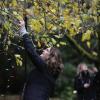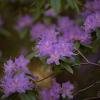July 16, 2009 - 8:21am
Inside a small, 10'x10' greenhouse tucked away in an inconspicuous corner of Vancouver Island University’s Nanaimo campus, Anne McCarthy points to a lush display of healthy vegetable plants including strawberries, tomatoes, cucumbers, and peppers.
“Can you believe it? It’s mid-summer and our strawberries are still blooming!”
McCarthy, a technologist in VIU’s Fisheries and Aquaculture department, has reason to be excited. She’s experimenting with a brand-new aquaponics system.
Aquaponics combines traditional hydroponics and aquaculture. “Think of it as gardening without soil and raising fish at the same time,” explains McCarthy. “The end result is sustainable food production.”
Aquaponics started at VIU about a year ago. Julie Vandenbor, a second year diploma student, and McCarthy found an online manual for a system called “barrel-ponics.” They built a mini system with recycled rain barrels, and grew plants in gravel.
Since then, McCarthy and students have developed a new, improved system. “We needed something more portable, so we took the best features from barrel-ponics and modified it. We found recycled fish tanks, pipes and polystyrene in the department, and built the new system. Now we don’t use gravel. The plants beds are always full of water. Those are the main differences.”
Nile Tilapia fish swim in a large tank filled with de-chlorinated city water. “We feed the fish koi pellets. Their job is to eat and excrete waste as urine and feces,” said McCarthy. The waste water is pumped into a clarifier tank, and the solid waste settles to the bottom where it can be flushed out and land composted if desired. The water, rich in dissolved nutrients, flows into the grow beds and feeds the plants like fertilizer. Plant roots hang through a polystyrene tray or ‘raft’ and soak up the nutrient rich water. The residual clean water is collected in a separate tank and pumped back into the fish tank. “The whole cycle starts again, so 100 percent of the water we use is recycled.”
McCarthy buys vegetable transplants from local nurseries, washes off the dirt, and places the root bulb in a net pot cup. One look at the lush green vegetable plants shows the system works.
“I bought strawberry transplants from a nursery and we ate our first berry in less than a month,” said McCarthy. “We’ve also been asked to grow herbs for VIU’s Culinary Arts department, including chives, sorrel, tarragon, thyme and basil. From 10 basil plants, we can harvest 300 grams of basil every three days and sell it to the Culinary program. Everyone is amazed at the rapid growth.”
The future of aquaponics at VIU has great potential, said McCarthy, who graduated from VIU’s Fisheries and Aquaculture program in 2005. “It can be used for educational purposes or to utilize the fish waste we produce here on campus in our Fisheries and Aquaculture program.
“Here at VIU, we’re looking at the possibility of incorporating aquaponics beside the new International Centre for Sturgeon Studies, which will be built at the Nanaimo campus starting this summer. It would allow us to reduce and reuse some of the fish waste that will be produced in that building, and contribute to sustainable food production at the same time.”
McCarthy would also like to see aquaponics expand into the community as a way to produce food sustainably.
Aquaponics has been around for years, but is gaining popularity in Canada and around the world as people look towards sustainable food production. McCarthy says systems are small enough for people in developing countries with few resources to put together, as well as backyard or hobby gardeners.
Interest in the environmentally friendly way of growing food is obvious. McCarthy’s YouTube video on VIU’s Fisheries and Aquaculture website, which highlights the VIU aquaponics project, has received over 20,000 hits in one year.
“The interest doesn’t surprise me,” she said. “People are serious about sustainability and being responsible for how we grow our food and how we treat water, one of our most precious natural resources. It just makes sense to protect it.”
For more information on VIU’s aquaponics program, visit the Fisheries and Aquaculture department website at www.viu.ca/fisheries
Tags: In the Community






